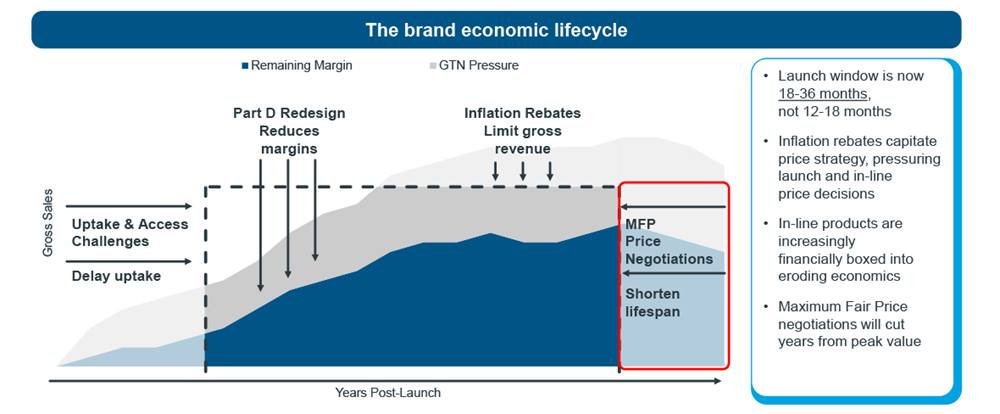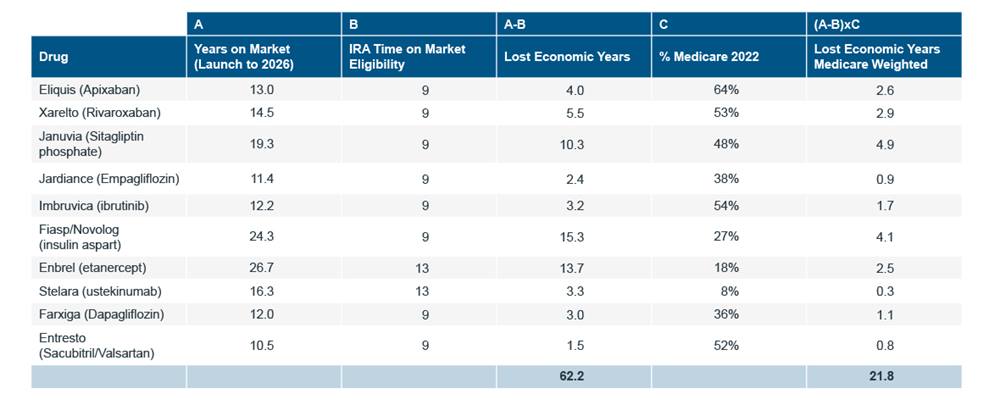Gain high value access and increase the profitability of your brands
















- Locations
- United States
- US Blogs
- How the Inflation Reduction Act is Changing the Rules in Life Sciences – Pt. 2
In continuation of IQVIA’s Inflation Reduction Act thought leadership series, the following is the second in a five-part blog series analyzing the first 10 products selected for Maximum Fair Price (MFP) negotiations. These 10 products represent the first of up to 100 products scheduled to be negotiated between 2023 and the end of the decade. The overall economic impact of the first 10 products belies the long-term impact on the life sciences industry, which will only grow as more products are added to negotiation.
Impact on economic lifecycleMaximum Fair Price negotiations shorten a product’s economic lifecycle by introducing a new Medicare event horizon at nine years for small molecules and 13 years for large molecule drugs. Effectively, MFP negotiations will act as a new Loss of Exclusivity date in the Medicare channel and operate independently of patent life. As such, the impact of a shortened lifecycle value can be immense, as it comes late when a brand is typically at its peak value.
The overall impact of current market dynamics on pharmaceutical products is pressuring value throughout the economic lifespan. While not the subject of this blog, launch and margin pressures are accelerating and also contribute to these trends. Adding in the truncation of Maximum Fair Price negotiations (red highlighted section) further adds to the pressures the industry will face over the next decade.

Source: IQVIA Market Access Center of Excellence
Of the 10 products selected, had the IRA been in effect at launch, a collective 24.8 years of Medicare revenue would have been impacted. It is important to note that economic life years are different than patent life years as the IRA MFP statutes operate separately from patent life. For example, Enbrel, as a large molecule drug which was first approved in May 1999, would have been subject to MFP negotiations at year 13 (May 2012). That effectively would have reduced 13.5 years of economic lifecycle in Medicare (January 2026 MFP start date less May 2012). Multiplying 13.5 years by Enbrel’s ~25% Medicare channel exposure demonstrates that the IRA would have cut a minimum of 3.4 years from the Enbrel economic lifecycle (13.5 years x 25%). Should there be broader spillover of MFP prices into the Commercially insured market, which represents ~65% of the Enbrel brand volume, the economic impact is greatly magnified to +12 years (13.5 years x 90%). The net sales impact would need to account for total deductions during that time, which would be brand specific and vary over time as rebates and other discounts have grown significantly over the past two decades.

Source: IQVIA Market Access Center of Excellence Analysis
As the list expands to the initial 100 products, the loss of economic lifespan will be measured in the hundreds of billions of dollars and hundreds of lost economic years. This will in turn affect changes in pipeline decisions as manufacturers look for products that face less impact by the Inflation Reduction Act. Increased focus on younger patient populations, large molecules, and rare and orphan diseases will mean that many products or indications that could benefit patients will not be pursued.
An additional impact for orphan designated drugs (ODD) will be the increased cost of gaining a second indication. Currently under the IRA, single indication ODD products are exempt from MFP negotiations. The cost of a second indication, despite high potential patient need, will materially impact the Net Present Value (NPV) of a drug. Since pursuit of a new indication can cost hundreds of millions of dollars with no guarantee of success, manufacturers will be faced with a decision either to pursue additional indication(s) which shortens the economic life of a drug or not to pursue the clinical research in order to protect a revenue stream for longer.
Shortening the economic lifespan of a product, however, is not the only secondary or tertiary impact from Maximum Fair Price. Generic and biosimilar manufacturers will also be faced with shifting economics, which could impact their pursuit of entering a branded market when loss of exclusivity occurs.
For example, if you consider a long monopoly drug (greater than 16 years on the market), the product would be subject to a minimum of a 60% discount in price. The new lower reference price for the market will alter a generic entry, which would typically occur with a 15-40% discount for the first generic in the market. By altering the net reference price, the market equilibrium for generic or biosimilars is also impacted.
Lost economic years for pharmaceutical products come at a high cost to the entire healthcare ecosystem. While system savings may be generated by mandating discounts earlier, the overall impact is suppressive in myriad ways. The compression of a brand’s economic window means that value needs to be pulled forward earlier into a product’s lifecycle. Altering investment strategy to meet a shorter economic lifespan means accelerating clinical development for multi-indication drugs, stacking indications instead of sequencing them, delaying launch as companies wait for supportive evidence to speed access decisions, and investing more into launch efforts to gain faster adoption.
At the time of publication, multiple lawsuits from the industry are pending in attempts to block all or pieces of the legislation from going into effect. For this blog, we will assume that the law is implemented as passed.
Special thanks to Ingrid Hirt, Jeanna Haw, James Brown, Rob Glik, Jeff Thiesen, Michael Kleinrock, and Mason Tenaglia for their contributions.

Explore Part 3 of the Inflation Reduction Act Series
The next blog in this series explores the impact of the Inflation Reduction Act on patient out-of-pocket costs. Will these new changes actually lead to economic relief for the patients that need it? Find out more.
You may also be interested in
Related solutions
Rely on market-leading strategists to help you achieve maximum access and profitability
Data, AI, and expertise empower Commercial Solutions to optimize strategy, accelerate market access, and maximize brand performance.




